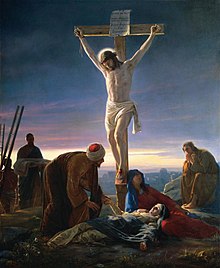
Back ظلمة أثناء الصلب Arabic Tma při ukřižování Czech Finsternis bei der Kreuzigung Jesu German Obskuriĝo dum la krucumo de Jesuo Esperanto Eclipse de crucifixión Spanish Gurutziltzaketaren ilunpe Basque تاریکی تصلیب Persian Obscurité de la crucifixion French Kegelapan saat Penyaliban ID Oscurità della crocifissione Italian


The crucifixion darkness is an event described in the synoptic gospels in which the sky becomes dark in daytime during the crucifixion of Jesus for roughly three hours.[1][2][3] Most ancient and medieval Christian writers treated this as a miracle, and believed it to be one of the few episodes from the New Testament which were confirmed by non-Christian sources. Modern scholars have found no contemporary references to it outside the New Testament.[4]
In his Apologeticus, Christian apologist Tertullian in AD 197 considered this not an eclipse but an omen, which is recorded in Roman archives. In his apologetic work Contra Celsum, the third-century Christian scholar Origen offered two natural explanations for the darkness: that it might have been the eclipse described by Phlegon of Tralles in his Chronicle or that it might have been clouds. In his Chronicle of Theophanes the fifth-century chronicler George Syncellus quotes the History of the World of Sextus Julius Africanus as stating that a world eclipse and an earthquake in Judea had been reported by the Greek 1st century historian Thallus in his Histories.
Modern scholarship, noting the way in which similar accounts were associated in ancient times with the deaths of notable figures, sees the phenomenon as a literary invention that attempts to convey a sense of the power of Jesus in the face of death. Scholars have also noted the ways in which this episode appears to draw on accounts of darkness from the Old Testament.
- ^ Matthew 27:45
- ^ Mark 15:33
- ^ Luke 23:44
- ^ Allison (2005), p. 88-96.